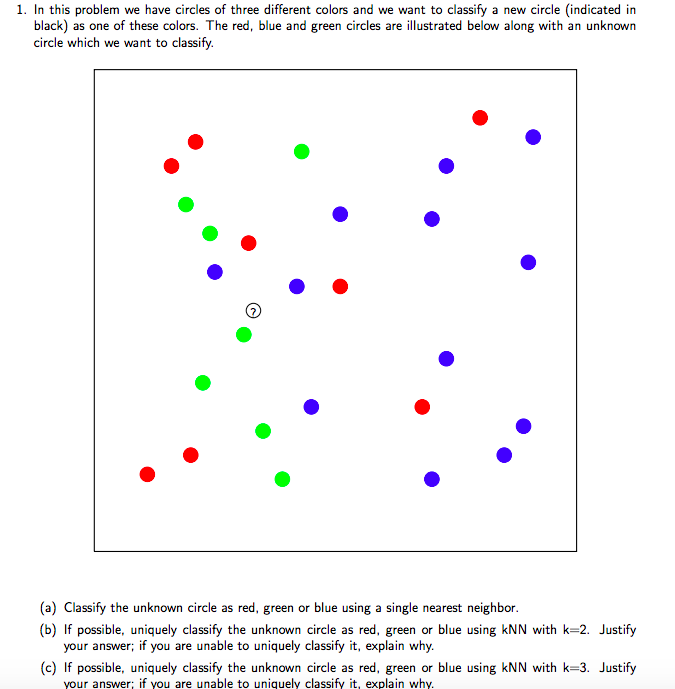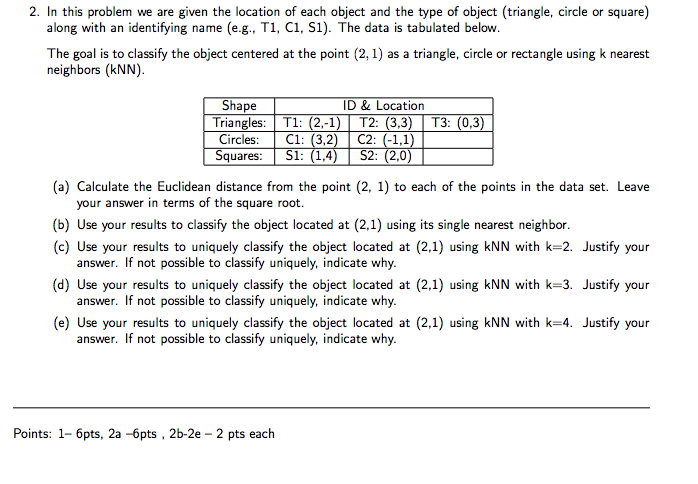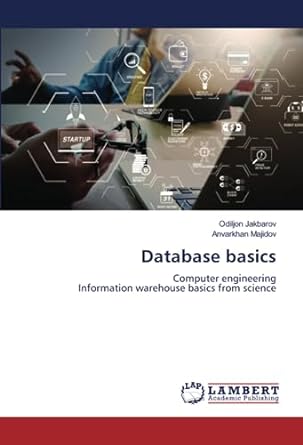

1. In this problem we have circles of three different colors and we want to classify a new circle (indicated in black) as one of these colors. The red, blue and green circles are illustrated below along with an unknown circle which we want to classify. (a) Classify the unknown circle as red, green or blue using a single nearest neighbor. (b) If possible, uniquely classify the unknown circle as red, green or blue using kNN with k=2. Justify your answer; if you are unable to uniquely classify it, explain why. (c) If possible, uniquely classify the unknown circle as red, green or blue using kNN with k=3. Justify your answer; if you are unable to uniquely classify it, explain why. 2. In this problem we are given the location of each object and the type of object (triangle, circle or square) along with an identifying name (e.g., T1, C1, S1). The data is tabulated below. The goal is to classify the object centered at the point (2, 1) as a triangle, circle or rectangle using k nearest neighbors (kNN). T3: (0,3) L Shape Triangles: Circles: Squares: ID & Location T1: (2,-1) T2: (3,3) C1: (3,2) C2: (-1,1) S1: (1,4) S2: (2.0) (a) Calculate the Euclidean distance from the point (2, 1) to each of the points in the data set. Leave your answer in terms of the square root. (b) Use your results to classify the object located at (2.1) using its single nearest neighbor. (c) Use your results to uniquely classify the object located at (2.1) using KNN with k=2. Justify your answer. If not possible to classify uniquely, indicate why. (d) Use your results to uniquely classify the object located at (2,1) using kNN with k=3. Justify your answer. If not possible to classify uniquely, indicate why. (e) Use your results to uniquely classify the object located at (2,1) using kNN with k=4. Justify your answer. If not possible to classify uniquely, indicate why. Points: 1-6pts, 2a-6pts , 26-2e - 2 pts each 1. In this problem we have circles of three different colors and we want to classify a new circle (indicated in black) as one of these colors. The red, blue and green circles are illustrated below along with an unknown circle which we want to classify. (a) Classify the unknown circle as red, green or blue using a single nearest neighbor. (b) If possible, uniquely classify the unknown circle as red, green or blue using kNN with k=2. Justify your answer; if you are unable to uniquely classify it, explain why. (c) If possible, uniquely classify the unknown circle as red, green or blue using kNN with k=3. Justify your answer; if you are unable to uniquely classify it, explain why. 2. In this problem we are given the location of each object and the type of object (triangle, circle or square) along with an identifying name (e.g., T1, C1, S1). The data is tabulated below. The goal is to classify the object centered at the point (2, 1) as a triangle, circle or rectangle using k nearest neighbors (kNN). T3: (0,3) L Shape Triangles: Circles: Squares: ID & Location T1: (2,-1) T2: (3,3) C1: (3,2) C2: (-1,1) S1: (1,4) S2: (2.0) (a) Calculate the Euclidean distance from the point (2, 1) to each of the points in the data set. Leave your answer in terms of the square root. (b) Use your results to classify the object located at (2.1) using its single nearest neighbor. (c) Use your results to uniquely classify the object located at (2.1) using KNN with k=2. Justify your answer. If not possible to classify uniquely, indicate why. (d) Use your results to uniquely classify the object located at (2,1) using kNN with k=3. Justify your answer. If not possible to classify uniquely, indicate why. (e) Use your results to uniquely classify the object located at (2,1) using kNN with k=4. Justify your answer. If not possible to classify uniquely, indicate why. Points: 1-6pts, 2a-6pts , 26-2e - 2 pts each








